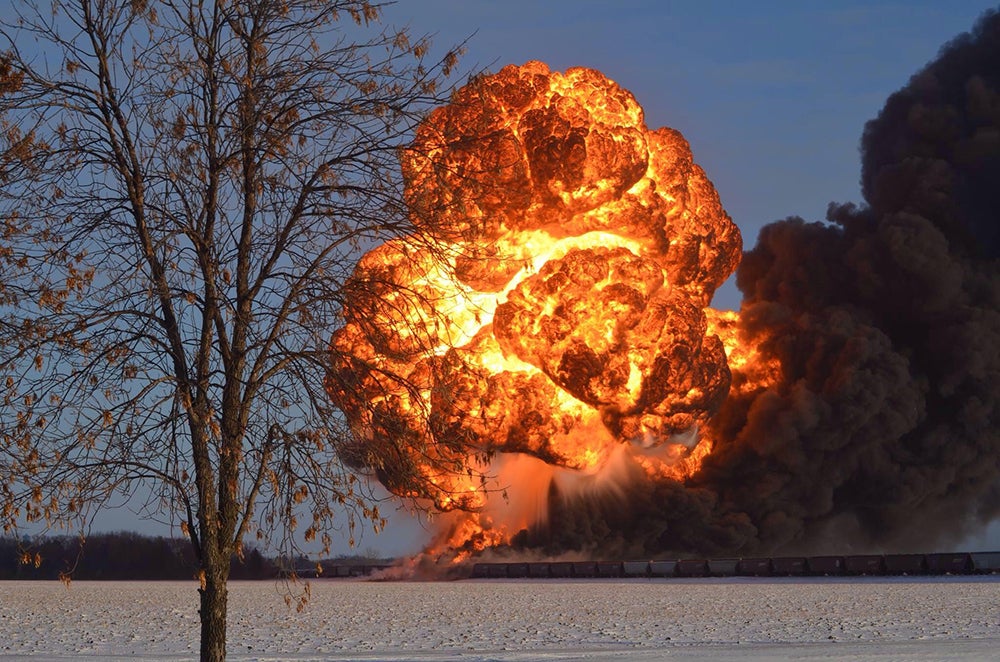A Tombstone Mentality On Exploding Oil Trains
It’s senseless to double the crude-by-rail fleet before replacing faulty oil train cars

This page was published 11 years ago. Find the latest on Earthjustice’s work.
Forty-seven people, including a four-year-old child, died in July 2013 when a train carrying crude oil derailed in Lac Mégantic, Quebec. Sixty-three tank cars derailed and of these, 59 punctured or ripped open and spilled oil, which ignited, exploded and destroyed the downtown. This catastrophe awoke the public to a 4,000 percent increase in the amount of crude oil shipped by rail and the incredible dangers posed by these crude oil trains to communities.
Last year—2013—has set the record for the amount of oil spilled on the rails, more in a single year than from the previous 37 years combined. More than 4,000 people were evacuated from their homes in 2013 when crude oil trains derailed, spilled oil and set off fireballs.
The National Transportation Safety Board, which investigates the train accidents, has long identified defective tank cars—called DOT-111s—as the prime culprit. In its words, “Clearly, the heads and shells of DOT-111 tank cars … can almost always be expected to breach in derailments that involve pileups or multiple car-to-car impacts.” And “recent railroad accidents have shown that using DOT-111 tank cars to ship flammable liquids creates an unacceptable public risk.”
Regulators in both the U.S. and Canada have vowed to impose safety measures to prevent more disasters. Time is of the essence for improved safety. The Safety Board has urged the Department of Transportation to impose an immediate ban on shipping explosive crude oil in the DOT-111s. And the Department estimates that 15 accidents will happen every year, plus a disaster of Lac Mégantic-magnitude every two years or so, until the DOT-111s and other defective tank cars are removed from the rails.
So what is the Department proposing to do? In its recent proposal, it floated a phase-out that would delay taking DOT-111s off the rails until October 2017 and then for only a portion of the crude-by-rail fleet (the rest would have another year). But before then, the oil industry plans to buy new tank cars to double the crude-by-rail fleet.
That’s right. The government has acknowledged the disaster risks and even predicted huge disasters, and yet its plan will allow the crude oil fleet to double before the DOT-111s are replaced with safer tank cars. Currently, there are approximately 50,000 tank cars in the crude fleet (30,000 are DOT-111s), and the industry wants to add 61,000 new tank cars to the fleet before using new tank cars to replace the DOT-111s.
And now the railroad and oil industries have joined forced to ask the Department to delay even further by adding another year onto the Department’s schedule. President of the American Petroleum Institute Jack Gerard told the press this week that the longer timeline request will allow tank car makers “to expand their operations while still producing new tank cars.”
Given what we know about these rail cars, it is unacceptable for the government to allow the industry to double the crude oil fleet before phasing out these extremely risky rail cars.
Last April, the Chair of the National Transportation Safety Board pleaded for an emergency ban on the DOT-111s, saying: “We don’t need a higher body count before they move forward. That is a tombstone mentality.” As she said, “We know the steps that will prevent or mitigate these accidents. What is missing is the will to require people to do so.”
Established in 1987, Earthjustice's Northwest Regional Office has been at the forefront of many of the most significant legal decisions safeguarding the Pacific Northwest’s imperiled species, ancient forests, and waterways.